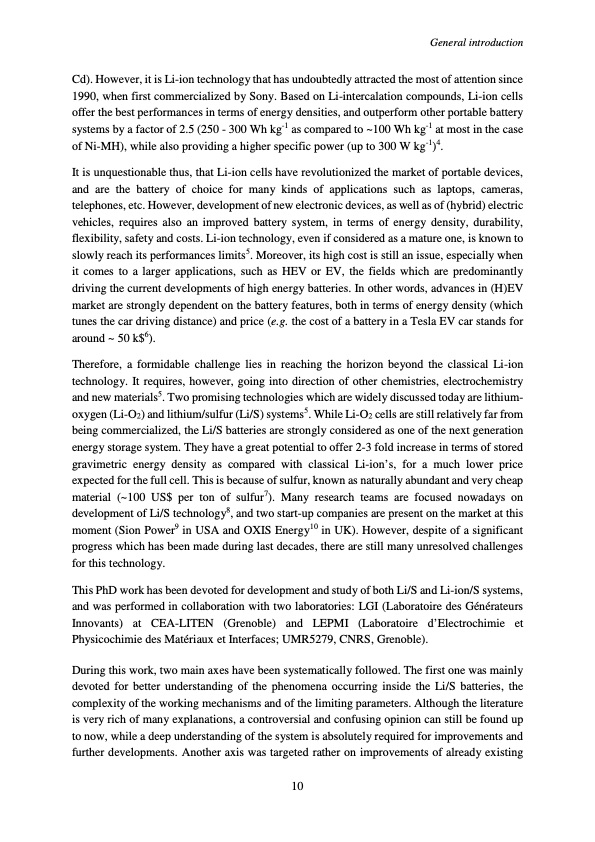
PDF Publication Title:
Text from PDF Page: 014
Cd). However, it is Li-ion technology that has undoubtedly attracted the most of attention since 1990, when first commercialized by Sony. Based on Li-intercalation compounds, Li-ion cells offer the best performances in terms of energy densities, and outperform other portable battery systems by a factor of 2.5 (250 - 300 Wh kg-1 as compared to ~100 Wh kg-1 at most in the case of Ni-MH), while also providing a higher specific power (up to 300 W kg-1)4. It is unquestionable thus, that Li-ion cells have revolutionized the market of portable devices, and are the battery of choice for many kinds of applications such as laptops, cameras, telephones, etc. However, development of new electronic devices, as well as of (hybrid) electric vehicles, requires also an improved battery system, in terms of energy density, durability, flexibility, safety and costs. Li-ion technology, even if considered as a mature one, is known to slowly reach its performances limits5. Moreover, its high cost is still an issue, especially when it comes to a larger applications, such as HEV or EV, the fields which are predominantly driving the current developments of high energy batteries. In other words, advances in (H)EV market are strongly dependent on the battery features, both in terms of energy density (which tunes the car driving distance) and price (e.g. the cost of a battery in a Tesla EV car stands for around ~ 50 k$6). Therefore, a formidable challenge lies in reaching the horizon beyond the classical Li-ion technology. It requires, however, going into direction of other chemistries, electrochemistry and new materials5. Two promising technologies which are widely discussed today are lithium- oxygen (Li-O2) and lithium/sulfur (Li/S) systems5. While Li-O2 cells are still relatively far from being commercialized, the Li/S batteries are strongly considered as one of the next generation energy storage system. They have a great potential to offer 2-3 fold increase in terms of stored gravimetric energy density as compared with classical Li-ion’s, for a much lower price expected for the full cell. This is because of sulfur, known as naturally abundant and very cheap material (~100 US$ per ton of sulfur7). Many research teams are focused nowadays on development of Li/S technology8, and two start-up companies are present on the market at this moment (Sion Power9 in USA and OXIS Energy10 in UK). However, despite of a significant progress which has been made during last decades, there are still many unresolved challenges for this technology. This PhD work has been devoted for development and study of both Li/S and Li-ion/S systems, and was performed in collaboration with two laboratories: LGI (Laboratoire des Générateurs Innovants) at CEA-LITEN (Grenoble) and LEPMI (Laboratoire d’Electrochimie et Physicochimie des Matériaux et Interfaces; UMR5279, CNRS, Grenoble). During this work, two main axes have been systematically followed. The first one was mainly devoted for better understanding of the phenomena occurring inside the Li/S batteries, the complexity of the working mechanisms and of the limiting parameters. Although the literature is very rich of many explanations, a controversial and confusing opinion can still be found up to now, while a deep understanding of the system is absolutely required for improvements and further developments. Another axis was targeted rather on improvements of already existing 10 General introductionPDF Image | Accumulateur Lithium Soufre

PDF Search Title:
Accumulateur Lithium SoufreOriginal File Name Searched:
WALUS_2015_archivage.pdfDIY PDF Search: Google It | Yahoo | Bing
Sulfur Deposition on Carbon Nanofibers using Supercritical CO2 Sulfur Deposition on Carbon Nanofibers using Supercritical CO2. Gamma sulfur also known as mother of pearl sulfur and nacreous sulfur... More Info
CO2 Organic Rankine Cycle Experimenter Platform The supercritical CO2 phase change system is both a heat pump and organic rankine cycle which can be used for those purposes and as a supercritical extractor for advanced subcritical and supercritical extraction technology. Uses include producing nanoparticles, precious metal CO2 extraction, lithium battery recycling, and other applications... More Info
| CONTACT TEL: 608-238-6001 Email: greg@infinityturbine.com | RSS | AMP |